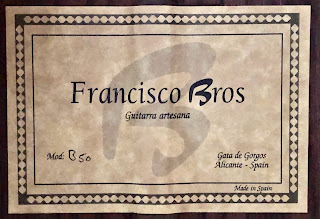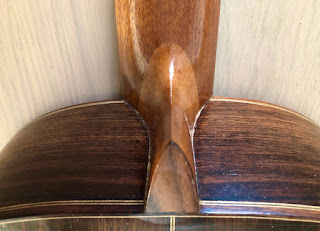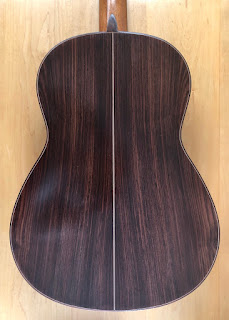At first I was able to buy the 1973 built guitar here
beyond. Impressed by its' quality I was encouraged to
buy another one from the same qualities, probably
even better sounding and in a near mint condition.
I've kept the 1973 in original condition but I've shaved
the neck of the 1971example as it felt too chunky.
Manuel Adalid Sr. built these guitars for Esteve and
here beyond you will find a part of the correspondence
with someone in charge of contact with clients in
which he states it to be comparable with the present
Concert models, priced at 6.000 Euro's.
This one in pristine condition is for sale: € 1500,-
Case included.
A closer look can be taken here by clicking on the
picture. A beautiful and straight spruce soundboard.
Scale of this a guitar is 650 mm while the width
of the topnut is 53 mm. Body frequency: Around
a low G which means 98 Herz.
Here the 12 hole bridge can be studied. Advantages are
that putting on new strings is easier but the better angle
over the bridgebone is of course the goal for this move.
And the rather intriguing rosette though the
light play in this picture isn't that great....
The "real color" is on the right side!
The soundboard as well as the back are in a near mint
condition. Unbelievable for such an old guitar. Probably
it was part of a big collection.
The double binding on the sides is an extra of course.
As the varnish is like it just came out of the window
in a shop, reflections are almost inevitable, though
the real photographer can die this much better. Alberto
Martinez makes pictures of guitars for his magazine
"Orfeo". He was a photographer for BMW and that
explains a lot.
In fact a bit difficult to attribute it to a luthier but
with some more effort we succeeded. Francisco
Adalid Sr. built this guitar. Later he worked
together with his son for a while. The 1973 guitar
is an example of that. The smaller round label on
the left is already pointing towards the Valencian
luthiers. This label probably has been printed on
the instructions of the Spanish Guitar Centre in
the UK. It was not uncommon to provide bigger
shops and companies with guitars that had no
label at all. Even between the different luthiers
this was common practice.
OK tuners but not that elaborate...
A simple headform as well but I can
appreciate that. No damages on both sides.
As can be expected, no fretwear as well. Recently
I discovered a label used by Manuel Adalid with
the name "Casa Garrijo - Madrid" on it. I think
Adalid must have the Casa Garrido in mind (??)
He most likely made guitars for that shop as well.
Francisco labelled guitar 1973
Definately a Francisco Esteve Concert guitar that has
been built by Manuel Adalid Sr. and Jr. but with a
rather disturbing label as this guitar was made for the
Spanish Guitar Centre in Newcastle upon Tyne in
Great Britain and thus bears their label. Superior
craftsmanship as can be admired in the shaping of
the rosette but also inner woodwork. SOLD
The round label looks a lot like the Tatay labels of that
time. Probably no coincidence as Esteve worked for the
Tatay company. Built in 1973 it is their 75th guitar
that year. Most likely numner 75 in this range.
At the bottom right the same rounded label can be seen
that is presented in this guitar. As was common these com-
panies often worked for Music shops and even other makers.
A beautiful back (and sides) this model is provided with.
It could even be Brasilian rosewood but we're not sure yet.
The upper picture has been taken after intensive French
polishing work that was needed to put it back in its'
old glory again. And thereby: It is a keeper.
A nice executed Rozette completes this furthermore
flawlessly built instrument. Inner woodwork is simply
of top quality. The golden Spanish Guitar Centre
label is sticked at the bottom. The soundboard is
strengthened with a traditional fan bracing and the
sound is as can be expected from a Valencian maker:
"Woody" and with a kind of springyness and lots
of volume and tone colour.
The bridge has been provided with a 12 hole construction.
More easily to put on new strings but moreover, a better
angle over the bridge bone and as a result a better tone.
Hardly any traces of play wear though there is a slight
craquelé visible at close inspection. In fact normal
regarding the age of this guitar.
Not any damges to the head that often occur when
placed against a wall.
The back and heel from another angle.
The tuners that work well.
The frets that are in a great condition and placed
in an ebony fingerboard.
The proof that this guitar was imported by the Spanish guitar
center in England and for that reason got another label.
I did some investigations at first as I was blown away by its'
sound qualities and already suspected it to be built by an
experienced luthier. I'll include the result of my E-mail
contact with the Francisco Esteve company here beyond.
You can click on it to enlarge this picture but the translation
has been placed here beyond for your convenience.
Good afternoon Noud,
I was quite certain but I wanted to verify with Manuel Adalid about this instrument.
“This guitar is how you can see a concert instrument, the best thing that I was doing
in Esteve's workshop at the time. It's a concert guitar because of the constructive
details that you correctly pointed out. These were made for the English house, the
Spanish Guitar Center”. We believe that all of it is finished in shellac, top and body.
It is possible that the overhead is from Palosanto de Río as well. It's a guitar on which
more than one luthier intervened and in which D. Manuel Adalid father (and the eldest)
did part of the work on it. It is artisan and entirely by hand. Today it would resemble a
60th Anniversary model, the most elaborate thing we do of concert models but with a
soundboard with a classic traditional system.
The recommended retail price of the model new 60th Anniversary is about 6000 euros
depending on the place due to taxes and rates of each country. You have a wonderful
instrument and we hope you enjoy it. It seems to be in good condition.
Regarding the Elec model, it is a model that we continue to manufacture today and is
the highest of range of electro-acoustic guitars with cut-away.
I hope it has helped you
Take good care of yourself and kind regards
Sergio Camargo



















































